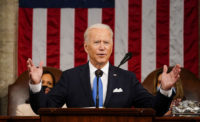Lark says the company also feels comfortable taking an equity stake in future P3 projects, in some cases. “We’re prepared to do it, if the [Lane] board thinks it’s right,” he adds.
Whether in the MidAtlantic region or elsewhere, Lark says the Cheshire, Conn.-based company can leverage the experience from its regional Chantilly, Va., office to help pursue technical proposals. Still, he recognizes that those business opportunities require significant resources. “You’re talking about committing 10 to 15 people for 18 months [when putting together proposals],” he says. “After all that, there’s a chance you’re not successful, but we’ve been fortunate enough that our hit rate is 50% so far.”
In the MidAtlantic, Lane is among many firms looking to team up and pursue a P3 agreement to design, build, finance and operate the proposed $2.2-billion Purple Line, a 16.2-mile light-rail project in Washington’s Maryland suburbs. The company is also hopeful that plans for a 25-mile HOT lane expansion of I-66 in northern Virginia could be let as a P3.
Although highway construction is the core of Lane’s work, the company has expanded its reach into the energy sector. When the natural-gas market took off and work ramped up around the Marcellus shale formation in the Northeast, Lane saw opportunities to provide local resources to national customers. “We quickly recognized that a lot of the work they needed built was things we’ve done for 100-plus years, such as major earthwork,” says Dennis Luzier, Lane senior district manager. “What you have to do in Texas to get a site ready is very different than what you have to do in the mountains of West Virginia or Pennsylvania.”
Energy work has leveled off as gas prices have dropped, but Luzier says he sees related opportunities in the power market. In 2013, Lane joined with Gemma Power Systems, Glastonbury, Conn., to build two 800-MW natural-gas-fired combined-cycle powerplants. The team’s Panda Liberty project in Bradford County, Pa., and Panda Patriot project in Lycoming County, Pa., each has an estimated value of $800 million.
Initially, the partnership was born out of necessity. Given the size of the two projects, which were to be built simultaneously, bonding companies wanted Gemma to have a partner, says Dan Martin, president of Gemma. The firm brought in Lane following a bond company recommendation, he says. “Lane’s desire to get into different types of infrastructure was the key,” he says. “Even though they don’t have experience building powerplants, they want to support infrastructure projects. They have heavy-civil experience that proved to be a good fit.”
While Lane can use the projects to gain experience in the power market, Martin says the company has helped Gemma rethink its own processes through suggestions about, for example, safety practices. “That’s been a real contribution,” he says. “We’ve been able to improve our program by association.”
Although electric power is a new market for Lane, Luzier notes that the Gemma joint venture follows the same philosophy that helped Lane break into P3s. “It’s about being a good partner,” he says. “When people start to engage with our company, they see that we have a solid safety record and understand that we have a strong work ethic. That’s something you can build on.”









Post a comment to this article
Report Abusive Comment